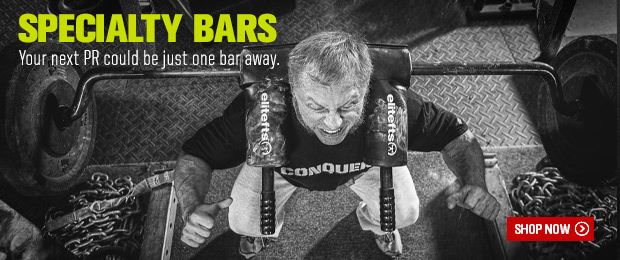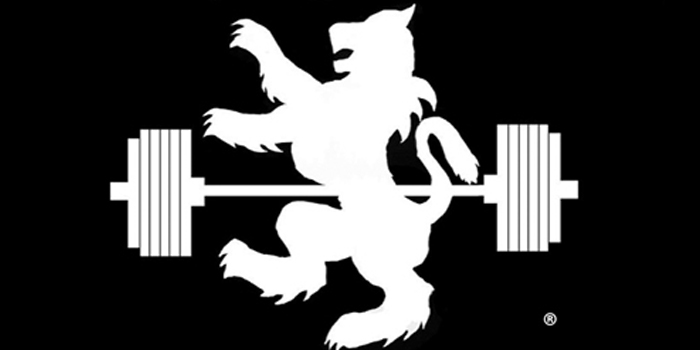
Two years ago, I introduced my daughter to resistance training. Then, she was a 13-year-old athlete, heavily involved in lacrosse with an excellent core strength foundation from years of gymnastics and tumbling. Our focus was on building a general strength base to improve her athletic performance (and general quality of life). We started with a single weekly session, which she supplemented with interval running, and specific lacrosse training exercises and drills.
In August of this year, we ramped up the training to two sessions per week and added some specific speed training. We recruited another coach to handle most of the speed sessions, which focused on form, explosive first steps, and improved ground force production through proper mechanics.
RECENT: Competing in the College Classroom
This article details some excerpts from the resistance training portion of our program.
The Ridiculous
“Don’t buy complexity; the simpler you make your training, the better the results become.” — Ryan Flaherty, Prolific Athletes
Once again, my garage gym is a mess. I love the garage gym. Sometimes I wish I had a little more space, but I know I am spoiled, and it is ridiculous.
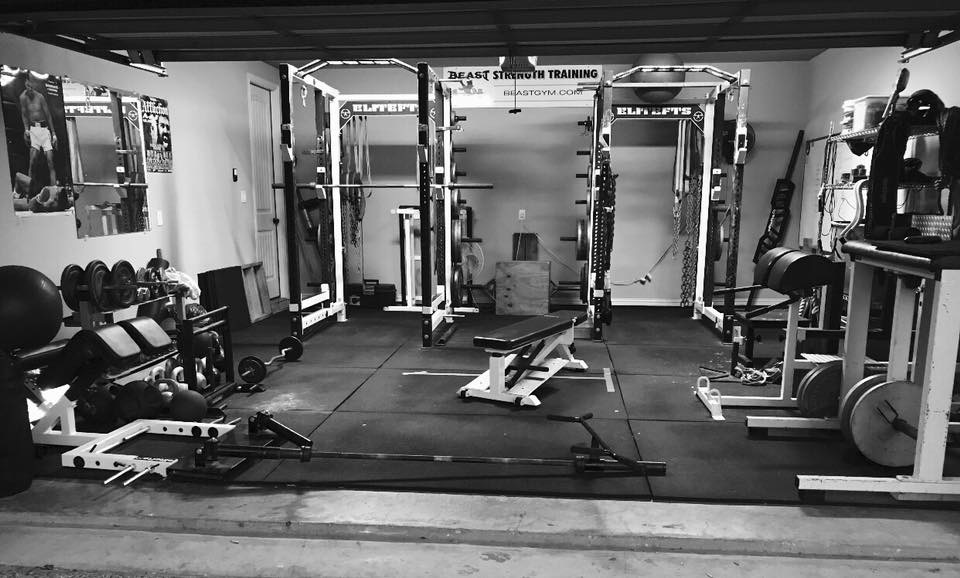
The horse stall mat-covered-gym-floor is littered with dog hair as of late, as Teddy, our German Shepherd mix, has been my nearly constant gym companion. The hair drifts amid the litter of elitefts Collegiate Power Racks, sandbags, elitefts specialty bars, and plates.
Teddy sometimes barks during my difficult sets, which is annoying, especially when he does it during the early sets — a constant reminder that my body has aged in dog years. Teddy, these aren’t supposed to be challenging.
Sometimes I utilize swimming sprints as a training session in my backyard pool. Teddy barks at me when my rest is too long between sets. It’s offensive. He is very judgmental.
We got a lot of use out of the garage gym this summer. I was pleased.
Athletic Endeavors
As mentioned in the opening paragraph, my daughter is mostly involved in lacrosse, where she plays attack — she is a passer, a playmaker who makes her teammates better (unselfish to a fault, which we have worked to improve — she needed to shoot more), but she needs more speed and quickness, as she continues to increase her level of competition.
Historically, her secondary sports included volleyball, basketball, and modest participation in track and martial arts. She was involved in gymnastics for years, especially tumbling, and as a result, is very physically strong with a solid core. For as long as I can recall, she has had above-average strength.
Most of her training is a variant of what we started a couple of years ago, with some added modalities and improvements that I have gleaned along the way.
Like most of you, I stand on the shoulders of giants because success begets success.
The Program (Session Example)
Dynamic Warm-Up
We start with some light foam rolling to loosen her up; it is probably superfluous, but old habits die hard, and even if the benefits are minor (i.e., getting the blood flowing), it does not detract from the training.
Concerning her dynamic warm-up, we previously utilized the same routine she followed in her lacrosse practices. The goal is to increase her muscle temperature along with a slight sweat, which isn’t hard to do in the Dallas climate.
We have made some tweaks along the way and now perform something akin to the following (we do this portion of the training outside on the grass and my preference is for her to wear her game cleats, and we set cones to measure the distance because I believe you practice the way you play):
RELATED: Combining Dynamic Hip and Stabilization Drills for Runners
- A-Skips — down and back 20 yards each way
- Walking Calf Stretch — 20 yards
- “Tin Soldiers” walking straight leg kicks — 20 yards
- Walking side lunge (side hip stretch)
- Skipping for height — 20 yards x 1-2 sets
- Skipping for distance – 20 yards x 1-2 sets
- Sprinting — 10 yards with an additional 19-yard deceleration
- Band Resisted Sprinting — 10 to 20 yards x 1-3 sets; we use a heavy band around her waist
- Flying Sprints (3 reps) — acceleration into a maximal sprint for 30 yards (we may time the last 10 yards)
Activation Exercises (Glutes and Quads)
Following the dynamic warm-up and sprints, we move inside. She slips into running shoes, and I have her perform some light glute activation exercises (typically hip bridges to fire up her glutes — bodyweight only). Then, we perform a quad activation exercise (e.g., bodyweight step-ups; 15 repetitions with each leg).
We warm up in the following manner:
- Full range warm-ups with the bar — 10 repetitions (the Hex Bar we utilize, also known as a Trap Bar, is 45 pounds)
- 2 minutes rest
- 5 repetitions with 95 pounds
- 2 minutes rest
- 2 repetitions with 135 pounds, explosive concentric off the floor with no eccentric (i.e., she drops the bar at the top of the lift)
- 2 minutes rest
Work Sets:
After determining my daughter’s maximum lift, we utilized a percentage-based program (i.e., for the first three weeks of the program, she performed three or four sets of eight repetitions with 65 percent of her 1RM).
We also perform a set of Jump Squats in-between each of the work sets (five repetitions as explosive as possible).
During Week 4 of the program:
- We progressed to about 70% of her 1RM for 4 sets of 5 repetitions
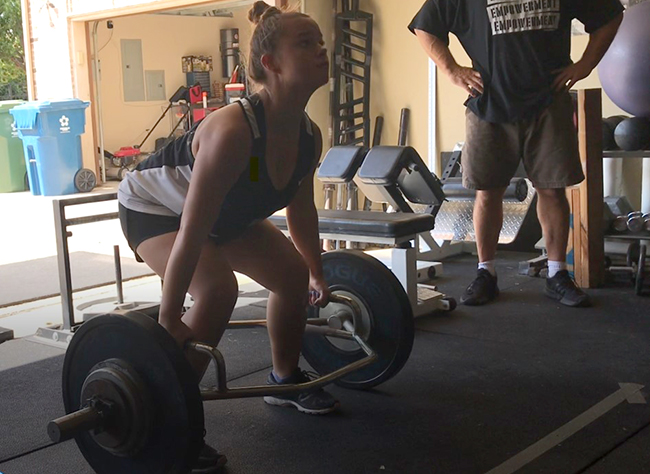
We ensure she maintains a tight core and an athletic posture. We chose this version of the deadlift because it requires less technical proficiency than deadlifting with a barbell. Additionally, I like the quad focus the Hex Bar variant offers (i.e., less stress on the lower back).
Two additional notes: Concerning the work sets, we are utilizing a variant I learned from Ryan Flaherty, where we remove the eccentric from the exercise by allowing the barbell to drop at the top of the lift, thereby reducing some of the hypertrophic effects of the lift (i.e., we are working on strength development, not size development).1
Unilateral Lower-Body Exercise
We utilize the Bulgarian Split Squat (lowering with a 5-second cadence and raising fast):
- 3 sets of 6 repetitions
- We initially started with bodyweight and have slowly added light dumbbells held in each hand
We believe unilateral leg training facilitates functional carryover to performance on the field when used as a supplement to bilateral training. Unilateral training is it is far more specific to the functions of nearly every sport. Jogging, running, and sprinting all occur with one leg hitting the ground at a time.
Unilateral training can assist with the rehabilitation and prevention of injuries, particularly with restoring strength balance between the injured and healthy limb. They do not necessarily put additional stress on the spinal column. As mentioned above, weighted unilateral exercises can be performed holding dumbbells (in lieu of placing a barbell across the trainee’s back).2
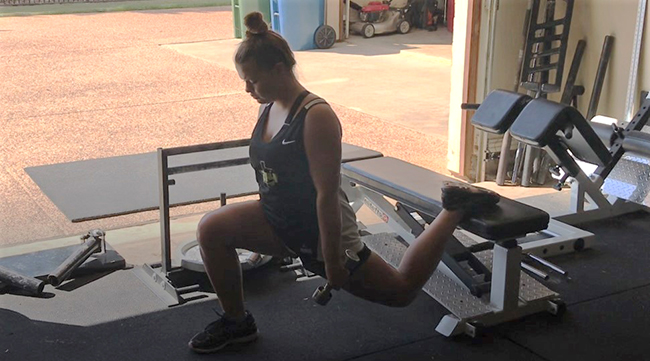
Single-Leg Step Downs (Ryan Flaherty-Style)
This is a stability exercise utilized after fatiguing the larger muscle groups in the lower body. We are trying to focus on the stabilization muscles, which will assist in injury prevention.1
We stand on a single leg on the edge of a high box (e.g., 18 inches) and lower the opposite foot down toward the floor until attaining a 45-degree bend in the working leg; the opposite foot should not touch the floor.
- 2 sets of 20 repetitions with each leg
- Utilize a 3-second eccentric (down) and 3-second concentric (up) cadence
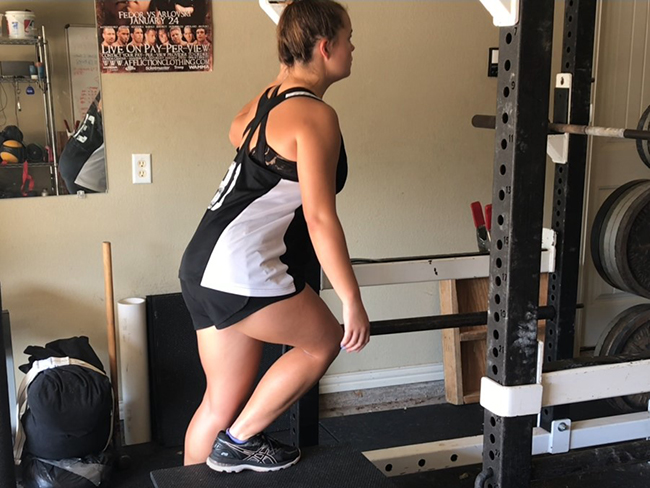
Slant Board Work
This is one of our secret exercises. This is another stability/proprioception exercise. I got this one from Nick Curson (Speed of Sport Gym in California).3 Training on a 45-degree slant board works ankle strength, flexibility, and mobility.
We train primarily in four directions on a single foot — think of it as facing north (toes toward the higher end of the slant board), south, east, and west. We started flat-footed, getting accustomed to balancing on a single leg. Then we added a reactive element (e.g., we toss a lacrosse ball back and forth while she maintains her balance).
Ultimately, we removed her running shoes and had her hold each position on her toes for about 30 seconds in each direction.
It is more challenging than it first appears.
7-Way Hips
This is another exercise variant I learned from Ryan Flaherty. The exercise targets the gluteus medius, which is one of the primary muscles that stabilize the pelvis during standing, walking and running.1, 4
This hip series works to build muscle endurance while assisting with lateral hip stability.
I need to share something with you regarding this exercise sequence. The burn it delivers has provided memories that will last a lifetime. My daughter and I typically perform this exercise together. She thrashes on the floor with exaggerated screaming (making the most bizarre faces) as we struggle through the circuit together (both of us apparently have weak hips).
Performing this exercise provides a combination of pain and hilarity I will not ever forget.
Training Summary
- Dynamic Warm-Up
- Activation Exercises (Glutes and Quads)
- Hex Bar Deadlift — 4 work sets of 5-8 repetitions (superset with 5 explosive Squat Jumps)
- Unilateral Lower-Body Exercise (Bulgarian Split Squat)
- Single-Leg Step Downs (Ryan Flaherty-style)
- Slant Board Work
- 7-Way Hips
Speed Sessions
As we mentioned at the outset, my daughter and I recruited another coach to handle most of the speed sessions, which focused on form, explosive first steps, and ground force production through proper mechanics.
We will tackle the detailing of the speed sessions in a future article.
References
- The Tim Ferris Show (Podcast); The Savant of Speed – Ryan Flaherty (#238)
- Baechle T.R. Earle R.W. Essentials of Strength Training and Conditioning. Third Edition. Champaign, IL: Human Kinetics; 2008.
- Nick Curson; Athletic Training Protocol Volume 1 (ATPv1); Speed of Sport
- BIM Lab: 7-Way Hip Series; https://balancemotion.com/bim-lab-7-way-hip-series/










